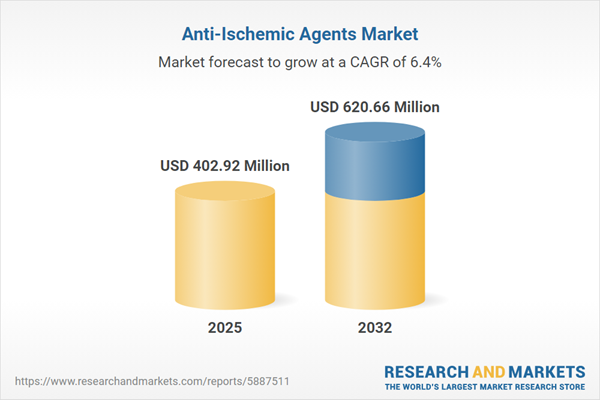Speak directly to the analyst to clarify any post sales queries you may have.
Senior leaders navigating the anti-ischemic agents market require up-to-date intelligence to inform strategy, investment, and operations. This overview offers actionable insights into current market dynamics, technological progress, and emerging trends, empowering decision-making across the healthcare ecosystem.
Market Snapshot: Anti-Ischemic Agents Market Size and Growth
The anti-ischemic agents market is showing reliable growth, driven by ongoing pharmaceutical innovation and an intensified global priority on cardiovascular health. In 2024, the market value reached USD 378.99 million and is anticipated to increase to USD 402.92 million by 2025. Projections indicate a rise to USD 620.66 million by 2032, at a compound annual growth rate (CAGR) of 6.36%. This upward momentum is steered by frequent clinical use, the shift toward patient-centric care models, and advancements in drug delivery. Market participants are adjusting their operations and portfolios to stay ahead of regulatory updates and new therapies. Flexibility in strategic planning is proving vital in this competitive setting.
Scope & Segmentation
- Drug Class: ACE inhibitors, beta blockers, calcium channel blockers, and nitrate formulations support targeted interventions for both acute and chronic ischemic events, helping providers tailor treatment to patient needs.
- Route of Administration: Intravenous, infusion, oral tablet, capsule, sublingual, and transdermal formulations are developed to meet diverse clinical scenarios, enabling adaptable care pathways and response time optimization.
- End User: Hospitals, clinics, ambulatory surgical centers, outpatient facilities, and home care providers use anti-ischemic agents to address situations ranging from acute emergencies to long-term disease management.
- Distribution Channel: Hospital pharmacies enable fast critical-care access, while retail and e-pharmacies extend ongoing therapy support, integrating with digital health solutions to increase patient engagement and accessibility.
- Application: Anti-ischemic solutions span immediate emergency intervention as well as secondary prevention, equipping providers for comprehensive clinical practice, from acute stabilization to risk reduction.
- Regions: The Americas, Europe, Middle East and Africa, and Asia-Pacific each involve unique regulatory landscapes and access requirements, guiding tailored approaches for market entry, compliance, and expansion.
- Leading Companies: Pfizer Inc., Teva Pharmaceutical Industries Ltd., Novartis AG, Bayer AG, AstraZeneca PLC, GlaxoSmithKline plc, Sanofi S.A., Bristol-Myers Squibb Company, Merck & Co., Inc., and Gilead Sciences, Inc. are advancing treatment options and expanding product portfolios.
Key Takeaways for Senior Decision-Makers
- Advancements in formulation and drug delivery facilitate improved patient adherence and efficiency, supporting both traditional and remote care environments.
- Integration of digital health systems allows for more tailored therapeutic strategies, enhancing provider collaboration and supporting patient-centered care models.
- Collaborative research efforts are generating new combination therapies, broadening therapeutic differentiation and nurturing development of new offerings in the sector.
- Segmented market analysis assists in targeted resource distribution and care model integration, allowing organizations to adapt as healthcare demands evolve.
- Constant evaluation of clinical outcomes enables proactive responses to regulatory shifts and helps organizations maintain a strong focus on safety and efficacy.
Tariff Impact: United States Supply Chain Adjustments
- Recent U.S. tariff adjustments have compelled organizations to modify procurement tactics by strengthening supplier networks and ensuring supply chain resilience.
- Strategic inventory controls and durable supplier partnerships are required to maintain access to therapies in both planned care and urgent settings.
- Pricing oversight is essential for preserving patient access to therapies and managing costs, reducing vulnerabilities during periods of market fluctuation.
Methodology & Data Sources
This report synthesizes insights from senior industry leaders, regulatory documents, clinical trials, national health data, and key policy resources. The approach prioritizes a data-driven perspective tailored to industry decision-makers in the anti-ischemic agents market.
Why This Report Matters
- Focused segmentation and specific recommendations enable efficient prioritization as the anti-ischemic agents market landscape changes.
- A consolidated data-driven perspective accelerates adaptation to new technologies and regulatory requirements for manufacturers, distributors, and payers.
- Actionable guidance supports supply chain resilience and responsive price management strategies amid ongoing change.
Conclusion
This analysis offers senior leadership clear direction and relevant recommendations, empowering organizational agility and readiness as the anti-ischemic agents sector transforms.
Additional Product Information:
- Purchase of this report includes 1 year online access with quarterly updates.
- This report can be updated on request. Please contact our Customer Experience team using the Ask a Question widget on our website.
Table of Contents
3. Executive Summary
4. Market Overview
7. Cumulative Impact of Artificial Intelligence 2025
Companies Mentioned
The companies profiled in this Anti-Ischemic Agents market report include:- Pfizer Inc.
- Teva Pharmaceutical Industries Ltd.
- Novartis AG
- Bayer AG
- AstraZeneca PLC
- GlaxoSmithKline plc
- Sanofi S.A.
- Bristol-Myers Squibb Company
- Merck & Co., Inc.
- Gilead Sciences, Inc.
Table Information
| Report Attribute | Details |
|---|---|
| No. of Pages | 183 |
| Published | October 2025 |
| Forecast Period | 2025 - 2032 |
| Estimated Market Value ( USD | $ 402.92 Million |
| Forecasted Market Value ( USD | $ 620.66 Million |
| Compound Annual Growth Rate | 6.3% |
| Regions Covered | Global |
| No. of Companies Mentioned | 11 |









